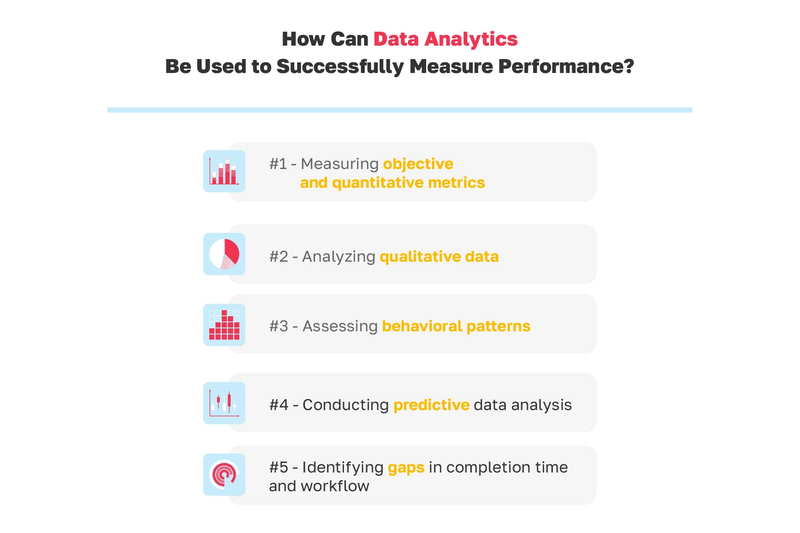Are you looking for a more efficient way to evaluate employee performance? Have you had enough of relying on subjective assessments that often miss crucial details? You may be feeling defeated because you don’t know how to measure your team’s contributions fairly.
We’ve all been there before, struggling to find the best approach to performance evaluation. That’s why, with our experience helping companies create more comprehensive evaluation processes, WillDom is here to show you how can data analytics improve the measurement of employees performance.
How Can Data Analytics Be Used to Successfully Measure Performance??
Data analytics transforms raw data into valuable insights, allowing businesses to make informed decisions. When applied to employee performance evaluation, it can provide a comprehensive view of an employee’s contributions.
Here are five ways data analytics can be used to successfully measure employee performance:

#1 – Measuring objective and quantitative metrics
Objective and quantitative metrics can include sales figures, project completion rates, and customer satisfaction scores. Companies can create a clear and unbiased picture of an employee’s performance by collecting and analyzing this data. For instance, a sales team can be evaluated based on the number of deals closed, revenue generated, and customer retention rates.
#2 – Analyzing qualitative data
Analytic tools can process and analyze qualitative data such as employee feedback, peer reviews, and client testimonials. By using natural language processing (NLP) and sentiment analysis, companies can uncover insights from written feedback that would be difficult to identify manually. Qualitative data can reveal, for example, an employee’s strengths in teamwork, leadership, and customer relations.
#3 – Assessing behavioral patterns
By tracking and analyzing data on work habits, communication styles, and time management, companies can gain insights into how employees approach their tasks. For example, data from project management tools can show how employees allocate their time, prioritize tasks, and collaborate with colleagues. With this data, managers can identify areas where employees need additional support.
#4 – Conducting predictive data analysis
Predictive data analysis leverages historical data to forecast future performance trends. It allows managers to proactively address potential issues and provide targeted employee support. For example, if data shows that an employee’s performance tends to decline during specific periods, managers can investigate the underlying causes and implement strategies to mitigate these effects.
#5 – Identifying gaps in completion time and workflow
Companies can pinpoint bottlenecks and inefficiencies that hinder performance by analyzing data from project management and workflow tools. For instance, if data reveals that specific tasks consistently take longer than expected, managers can investigate the reasons and implement improvement plans. Addressing these gaps can lead to more streamlined workflows and better resource allocation.

The Downfalls of Businesses Not Using Data Analytics to Measure Performance
Without the insights provided by data analytics, companies are left relying on outdated and often flawed methods of evaluation. This can lead to several issues that affect both individual and organizational performance.
Here are five significant downfalls of not using data analytics in performance measurement:
#1 – Subjectivity and bias
Performance evaluations often rely heavily on personal opinions and subjective judgments without data analytics. This can introduce bias into the evaluation process, resulting in unfair assessments and potentially damaging employee morale. Objective data helps ensure that evaluations are based on measurable criteria rather than personal preferences or prejudices.
#2 – Data overload
Manual performance evaluation methods can result in overwhelming data that is difficult to process and analyze effectively. Without the right tools to manage and interpret this data, businesses can struggle to identify meaningful patterns and insights, leading to incomplete or inaccurate evaluations.
#3 – Limited insights
Traditional evaluation methods may overlook essential performance indicators that data analytics can easily capture. This results in a limited understanding of an employee’s actual contributions and potential areas for improvement. Integrating various metrics and feedback sources provides a more comprehensive view.
#4 – Time-consuming processes
Collecting, organizing, and analyzing performance data manually is time-consuming and labor-intensive. This process can divert valuable resources from more strategic initiatives and slow decision-making. Data analytics automates many tasks, allowing managers to focus on actionable insights and strategic planning.
#5 – Inconsistent performance measurement
Without standardized metrics and a data-driven approach, performance evaluations can vary widely from one manager to another. This inconsistency can lead to confusion and frustration among employees and a lack of trust in the evaluation process. Data analytics provides a consistent framework for measuring and comparing organizational performance.
Best Practices for Implementing Data Analytics in Performance Measurement
Successfully integrating data analytics into employee performance evaluation requires a strategic approach. By following best practices, businesses can ensure a smooth implementation process and maximize the benefits of data-driven insights.
Here are four essential best practices you can begin implementing for employee performance measurement:
#1 – Define clear objectives and KPIs
Start by establishing clear objectives and key performance indicators (KPIs) that align with your organizational goals. Defining what you want to achieve with your performance evaluations will help you select the right data points to track and measure. KPIs should be specific, measurable, attainable, relevant, and time-bound (SMART) to provide a clear framework for performance assessment.
#2 – Choose the right tools and technologies
Consider your organization’s needs and the data types you will be analyzing. Look for tools with robust analytics capabilities, user-friendly interfaces, and seamless integration with your existing systems. The right technology will enable you to efficiently collect, analyze, and interpret performance data.
#3 – Implement a pilot program
Start with a pilot program before rolling out a full-scale data analytics program. A pilot program helps ensure your strategy is fine-tuned and ready for broader implementation. It allows you to test the effectiveness of your chosen tools and methodologies in a controlled environment. Gather feedback from users, identify any challenges, and make necessary adjustments.
#4 – Use real-time analytics
Leverage real-time analytics to monitor performance continuously and make timely interventions. Real-time data provides up-to-date insights into employee performance, allowing managers to address issues as they arise and support employees proactively. This approach fosters a culture of continuous improvement and helps maintain high levels of productivity and engagement across the organization.

We Can Help You Measure Employee Performance with Data Analytics!
Data analytics can be overwhelming. The volume of data and the need for precise interpretation can leave anyone feeling like a lost cause. Hiring a professional data analytics services provider is the best option. Experts can guide you through the process, ensuring you make the most of your data and turn it into actionable insights for your business.
At WillDom, we specialize in data analytics services. Our experienced professionals are dedicated to helping you implement a comprehensive and effective performance evaluation system. With our expertise, you can transform your performance evaluations and make them more accurate.
Contact WillDom today and let us help you leverage data analytics to enhance your employee performance evaluation process!

